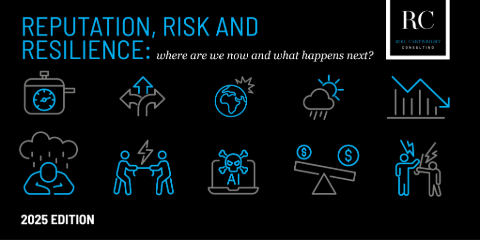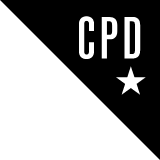Reputation, Risk and Resilience report 2025: rethink crisis and reimagine risk
The author of this year’s Reputation, Risk and Resilience report explains why crisis is an untapped source of value and material opportunity.
As professional communicators, public relations advisors, and business leaders, we operate in a world where the major risk ‘buckets’ dominating expert and public concerns are becoming remarkably consistent. That said, while the overall risk landscape is relatively stable, these ‘steady-state’, dominant risks – increasingly interconnected, mutually-reinforcing, structural and systemic – are intensifying almost by the day.
That is the core finding of the 2025 edition of my annual Reputation, Risk and Resilience report [of which the CIPR is an industry partner]. Within the publication I’ve summarised and analysed 11 major global reports – totalling a table-thwacking 834 pages of source material – on those interlocking topics.
And yet for all the undoubted volatility, uncertainty and complexity, I double down on my argument that our response must be to fundamentally rethink crisis, reimagine risk and re-engineer preparedness.
More specifically, I unapologetically revisit my consistent argument that there is real opportunity lurking beneath the sense of permacrisis – the chance to use risk management, crisis preparedness and resilience-building as sources of hugely positive tangible value and material opportunity, rather than viewing them as irksome, costly insurance policies.
To unlock that opportunity, crisis communicators need to act as ‘sense-makers-in-chief’, focusing as much on relationships as reputation, shifting focus from ‘the self’ to ‘the other’, recognising that character-centred scandals can eat capability-led crises for breakfast and prioritising critical human infrastructure over technical systems and processes alone.
Putting reputation, risk and resilience together
This journey of discovery originally started in January 2023, when I started hearing voices. Before you panic, let me explain. I was ploughing through the wall of reports on trust, risk and resilience published just ahead of Davos – 300+ pages in total that year.
I said to myself, “wouldn’t it be great if someone had synthesised all of this – that would be so much easier!”. A little voice in my head replied, “what a great idea – why don’t you do it, Rod?”. So, thanking the second voice for ruining the next few weeks of my life, I did just that – producing a report in February 2023 called Trust, Risk and Resilience: Where are we Now and Where Next?
In it, I synthesised five major global reports on those interconnected topics, including a “TL;DR” (‘too long, didn’t read’) summary of each report, a synthesis of the 10 key themes running through them and ten practical recommendations for action.
The reaction globally was quite remarkable, so I repeated the exercise in mid-2024, extending the 2024 report’s coverage to eight global publications from the 12 months to last May. That expansion added important work from Gallup, G4S and the Business Continuity Institute (BCI), allowing me to draw in the crucial topics of employee engagement, security and business continuity.
Fast forward to the release of the 2025 Edition on 28 May and I’ve again expanded the scope to eleven reports – including new corporate affairs surveys from Deloitte and Oxford University / GlobeScan, the Lloyds Register Foundation World Risk Report and AXA’s Future Risks Report.
Practical solutions
This year’s report again explores, analyses and dissects a set of interlinked issues that may never have been more pressing, nor more mission-critical, for organisations of all kinds – at least not in my professional lifetime.
To avoid simply “admiring the problem” (to borrow a phrase from the UK’s National Preparedness Commission), I have placed an even stronger emphasis on recommendations for the practical responses needed to manage the risks and deal with the challenges it raises.
There are, of course many senior people on boards and in senior leadership teams who continue to view crisis preparedness rather like a costly, irksome insurance policy that they may never need and deeply resent paying for. However, beyond the almost weekly examples of the immense damage that operational, reputational and relationship crises create, there is a growing body of hard data which puts to the sword that misguided and all-to-often complacent mindset.
For that evidence, we need look no further than the remarkable SenateSHJ Crisis Index – released last month – analysing the financial impacts of over 300 listed company crises globally over the past 44 years, using data from 27 stock exchanges and across 32 industry sectors.
Over that period, the average crisis was met with a share price impact of over 35%, with earnings per share (EPS) falling 68.3% and companies taking 425 days, on average, for their share price to return to pre-crisis levels. Corroborating a view I’ve long held that stakeholders already ‘price in’ – to a degree – the impact of operationally-focused crises, ‘mismanagement’ and ‘white-collar crime’ hit share prices hardest, with ‘cybercrime’ having the lowest share price impact.
For those minded to persist with the ‘expensive insurance’ view of crisis preparedness, I throw down an intentionally provocative gauntlet in the 2025 report, in the form of a one-page ‘Letter to the CEO and chair’.
Imagine – I assert – if I offered you an insurance policy that not only paid for damage to your home from a passing storm, but actually helped find – and repair – unseen cracks in the building’s walls and fundamental weaknesses in its foundations. You would probably bite my arm off! And yet, that is precisely what the systematic, collaborative risk readiness and crisis preparedness that so many executives consistently resist is able to do. That is why, I argue, we need to keep talking about crisis preparedness and risk management as sources of considerable tangible value and material opportunity.

The 10 key themes
As before, I have drawn out the 10 key themes that run like a red thread through the publications summarised and analysed – together with ten practical recommendations, stemming from the all the research findings. However, I have also added three ‘major risk dynamics’, into which I’ve grouped the key themes.
Firstly, we have ‘steady-state table stake’ risks – the undeniable top-tier threats that consistently dominate corporate risk registers. Those table stakes are the geopolitics of conflict, economic fear, cyber insecurity, and climate emergency.
However, there is also a series of ‘sleeping giant’ risks, hiding in plain sight and all too often downplayed or even ignored. These potential blind spots may yet become more prominent over the coming years. These include the enduringly uncertain relationship between humans and technology; the demographic and societal impact of super-ageing societies; growing social tensions and intergenerational divides; and the hidden pandemic of plummeting mental health and wellbeing, accompanied by growing employee disengagement.
Finally, both the table stakes and the sleeping giants are being exacerbated by a set of ‘risk accelerants’: increasingly embedded systemic polycrises and structural permacrisis; ever-greater risk intersectionality and threat interconnectedness; and an excessive focus on operational and structural resilience over true human preparedness and critical human infrastructure.
As much as each of the report’s 10 individual key themes merits careful scrutiny in its own right, standing back to consider the specific role of each of these overall risk dynamics in driving organisational outcomes and informing strategic responses is every bit as important – if not more so.
What happens next?
Producing Reputation, Risk and Resilience is no small undertaking. It is also an undeniable labour of love, both practically and – increasingly – emotionally, given the flux and tumult in which we now live. That said, I wouldn’t change it for the world, and it is a crucial part of my work and contribution to an industry I love.
It would be churlish to suggest that this 2025 edition will make a particularly cheery read. There is simply no hiding from the fact that we live in a world of complexity, uncertainty and fear. However, I believe passionately that issues and crises are – in reality – nothing more than vulnerabilities manifested, risks realised, and threats materialised.
How we respond to the ‘stimulus’ of today’s undeniably complex risk environment is in our hands – professionally and personally. The sooner we acknowledge, internalise, and culturally embed the fact that there is opportunity in every risk, and risk in every opportunity, the better prepared we will be for what lies ahead.

Rod Cartwright is a UK and EU-based strategic communication advisor with over 25 years’ global PR agency experience, working closely with in-house teams, agencies, and senior leaders to build communication resilience. A special adviser to the CIPR's Crisis Communications Network, he specialises in crisis communication, executive preparedness, leadership communication, and reputation management, and has counselled top organisations, including IATA, Nissan, IBM, Dell, KFC, and Qatar Foundation.
Get skilled
Want to strengthen your crisis and reputation management skills? The CIPR offers a range of practical training courses and a part-time Crisis Communication Diploma to help you build expertise and confidence when handling crises.
Further reading
Gary Lineker to leave BBC: a PR professional's view of the row
This is not just any crisis comms email, this is an M&S crisis comms email
Andy Coulson: 'I enjoy doing crisis comms work because I lived it.'


